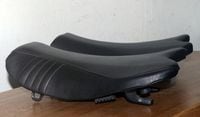After more than 20 years as a windscreen specialist, Zero Gravity began producing comfy-yet-sporty seats. This early-production Latigo Sportbike Saddle was purchased for my primary streetbike, a then-stock 2007 Suzuki GSX-R1000.
The Latigo is built on a stout base made of ABS plastic. Counterintuitively, this platform is slightly narrower than stock. Their length is identical. Once saddled with ZG’s proprietary foam, things make more sense. The Latigo is ¼-inch wider near the front and about ½-inch wider out back, resulting in a ½-inch taller overall seat height.
Covering the company’s specially formulated, proprietary foam is a marine-grade material nearly twice as thick as the Suzuki’s nondescript skin. At exactly two pounds, the Latigo weighs just 6.4 ounces more than the GSX-R seat, which is much lighter than most aftermarket sportbike saddles.
Testing took place while transforming Suzuki’s seven-time MotoAmerica Superbike champ into a versatile supersport tourer without dulling its performance. Stage 1 ergonomic enhancements consisted of a higher Zero Gravity Sport Touring windshield, taller HeliBars TracStar clip-ons and lower footpegs. More recently, a Renthal Road handlebar mounted atop an aftermarket triple clamp literally raised the bar by eight inches. Modernized with Triton Blue color scheme by SBKPaint, this GSX-R not only looks like Suzuki’s fully faired GSX-S1000F, its seat-bar-peg relationship is quite similar.
The seat swap took less than five minutes while transferring the six original rubber bumpers and vibration dampers to the Latigo’s base. It mounted perfectly and hugged the tail section without leaving scratches or wear marks.
First impression? Planted. A few milliseconds in the cover’s grip, my brain comprehended the glute-delivered message: Zero Gravity defined the Latigo as a sportbike saddle for good reason.
The Latigo offers more traction than the stock saddle to better set and hold body position while braking, cornering and accelerating. Once accustomed to the available grip, it doesn’t hinder side-to-side or back-to-front mobility when riding aggressively or at a more sedate pace.
Of course, a seat cover’s surface tension is relative. To be fair, the stock seat isn’t as grippy, but doesn’t feel as if it’s been soaked in WD-40. It provides some traction, but the ZG cover’s chemical and physical properties and its much sharper rise up front, more effectively keep me from unintentionally sliding around and into the fuel tank--solo or two up.
Soft to the touch, the Latigo’s wider, high-density foam distributes my posterior contact patch more evenly. This reduces hot spots and discomfort previously experienced on hour-long freeway commutes to canyon-dancing nirvana. On all-day, 500-mile sorties, such as backroad pilgrimages to Laguna Seca, long stints in the saddle are still a pain in the butt, but the pain creeps up more gradually.
Today, the Latigo cover looks new and is still much more comfortable than stock. That said, its foam softened up over time, became a bit spongy and the base’s sharp, rearmost side edges are sometimes felt through the foam while hanging off the bike in tight corners.
Nonetheless, among the hundreds of stock and aftermarket seats I’ve sampled, tested or owned, the Latigo is one of the best for sport riding and light-duty touring. There are many good reasons it’s still mounted on my primary ride--three years and 15,000 miles later.
Zero Gravity seats fit 2008 to 2016 GSX-Rs and Hayabusas, as well as select Ducati, Honda, Kawasaki and Yamaha sportbikes.
Zero Gravity Latigo Sportbike Saddle
Price: $259.95
Contact: zerogravity-racing.com
MC Grade: B+
Verdict: Everyone knows that most replacement seats are comfortable. This sportbike-specific saddle also offers increased human-to-machine grip for better bike control.











/cloudfront-us-east-1.images.arcpublishing.com/octane/STLDSHQ6PX6GW6FS3F3WROCHVE.jpg)


/cloudfront-us-east-1.images.arcpublishing.com/octane/VZZXJQ6U3FESFPZCBVXKFSUG4A.jpg)
/cloudfront-us-east-1.images.arcpublishing.com/octane/QCZEPHQAMRHZPLHTDJBIJVWL3M.jpg)
/cloudfront-us-east-1.images.arcpublishing.com/octane/HXOUJXQWA5HBHGRO3EMJIGFMVI.jpg)

/cloudfront-us-east-1.images.arcpublishing.com/octane/3TIWWRV4JBBOLDVGRYECVVTA7Y.jpg)
/cloudfront-us-east-1.images.arcpublishing.com/octane/KIX5O23D5NAIBGFXBN3327DKZU.jpg)
/cloudfront-us-east-1.images.arcpublishing.com/octane/7GJYDUIPXRGMTMQKN6ONYOLBOU.jpg)
/cloudfront-us-east-1.images.arcpublishing.com/octane/MUQLOVLL2ZDGFH25ILABNBXKTI.jpg)
/cloudfront-us-east-1.images.arcpublishing.com/octane/TNOU5DNE2BC57MFPMGN2EIDXAM.jpg)
/cloudfront-us-east-1.images.arcpublishing.com/octane/GTCXACQGJ5HAPDTGWUQKDEH44E.jpg)
/cloudfront-us-east-1.images.arcpublishing.com/octane/S35YGSEMEZB4BLTDJTSZPF4GLA.jpg)
/cloudfront-us-east-1.images.arcpublishing.com/octane/5UOT6HPX2JFMRJAX6EH45AR4MQ.jpg)
/cloudfront-us-east-1.images.arcpublishing.com/octane/OKWOJWAKP5EP3OACCRRWPCIX2Q.jpg)
/cloudfront-us-east-1.images.arcpublishing.com/octane/2WF3SCE3NFBQXLDNJM7KMXA45E.jpg)
/cloudfront-us-east-1.images.arcpublishing.com/octane/G4MG6OUCJNBSHIS2MVVOTPX65E.jpg)
/cloudfront-us-east-1.images.arcpublishing.com/octane/IIGGWFOTOJGB7DB6DGBXCCMTDY.jpg)
/cloudfront-us-east-1.images.arcpublishing.com/octane/QSTCM6AVEZA5JJBUXNIQ3DSOF4.jpg)
/cloudfront-us-east-1.images.arcpublishing.com/octane/U4I7G625B5DMLF2DVIJDFZVV6M.jpg)
/cloudfront-us-east-1.images.arcpublishing.com/octane/B6XD6LS6IVCQPIU6HXDJSM3FHY.jpg)
/cloudfront-us-east-1.images.arcpublishing.com/octane/ICL63FEDDRDTTMINYICCEYGMDA.jpg)
/cloudfront-us-east-1.images.arcpublishing.com/octane/FCGZHQXRBZFLBAPC5SDIQLVF4I.jpg)
/cloudfront-us-east-1.images.arcpublishing.com/octane/WNOB6LDOIFFHJKPSVIWDYUGOPM.jpg)

/cloudfront-us-east-1.images.arcpublishing.com/octane/X33NU3E525ECRHXLNUJN2FTRKI.jpg)